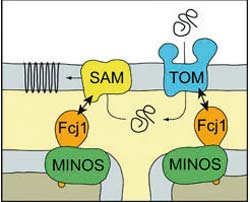Molecular Switches in the Cellular Power Plants

The protein complex MINOS plays a key role in the formation of the two membrane systems of mitochondria. MINOS is necessary for the architecture of the inner membrane and helps TOM and SAM embed proteins in the outer membrane by forming membrane bridges. Source: Ralf Zerbes<br>
A team of scientists at the University of Freiburg led by Dr. Martin van der Laan has achieved groundbreaking new insights into the structure of mitochondria. Mitochondria are the microscopic power plants of the cell that harness the energy stored in food, thus enabling central life functions.
This conversion of energy takes place in delicately formed cavities of the biological membranes inside mitochondria. Defects in these fine membrane structures can lead to severe diseases of the muscles and the central nervous system.
A sophisticated molecular machine of the inner membrane that the Freiburg team already discovered in 2011 is not only responsible for forming the characteristic structures within mitochondria but evidently also plays an important role in assembling the outer membrane enclosing these organelles, as the scientists now report in the renowned journal Molecular Biology of the Cell.
The protein machine studied by the scientists is essential for maintaining the typical architecture inside the mitochondria and have thus received the name “Mitochondrial Inner Membrane Organizing System” (MINOS). In their latest study, the Freiburg researchers and their colleagues in Graz, Austria, Warsaw, Poland, and Groningen, Netherlands, demonstrate that the role of MINOS in creating the mitochondrial architecture is clearly more extensive than previously assumed.
In a joint research effort between the Collaborative Research Center 746 and the Cluster of Excellence Centre for Biological Signalling Studies (BIOSS), Dr. Maria Bohnert, Lena-Sophie Wenz, and Ralf Zerbes found out how MINOS connects the distinct membrane systems of the mitochondria with each other.
The membrane complexes SAM and TOM play a key role in this process. They use tunnel-shaped structures to transport proteins into the mitochondrion and then embed them in the outer membrane. In their latest study, the Freiburg scientists demonstrate that the MINOS component Fcj1 of the Mitofilin protein family participates directly in this process, which is essential for the survival of the cells.
The inactivation of Fcj1 inhibits the integration of proteins into the mitochondrial outer membrane. These findings show how molecular switches affecting the connectivity of mitochondrial membranes control the assembly and function of the cellular power plants. These newly gained insights improve our understanding of the basic principles of the architecture of mitochondria. In the future they could help scientists to understand and influence mechanisms of diseases that involve changes in the fine structure of mitochondria.
Original Publication:
Bohnert M, Wenz LS, Zerbes RM, Horvath SE, Stroud DA, von der Malsburg K, Müller JM, Oeljeklaus S, Perschil I, Warscheid B, Chacinska A, Veenhuis M, van der Klei IJ, Daum G, Wiedemann N, Becker T, Pfanner N, van der Laan M: “Role of MINOS in protein biogenesis of the mitochondrial outer membrane”, in: Molecular Biology of the Cell, published online August 23, 2012.
http://www.molbiolcell.org/content/early/2012/08/20/mbc.E12-04-0295
Contact:
PD Dr. Martin van der Laan
Institute of Biochemistry and Molecular Biology
Collaborative Research Center 746
University of Freiburg
Phone: 0049 (0)761/203-5270
E-Mail: martin.van.der.laan@biochemie.uni-freiburg.de
Media Contact
More Information:
http://www.uni-freiburg.deAll latest news from the category: Life Sciences and Chemistry
Articles and reports from the Life Sciences and chemistry area deal with applied and basic research into modern biology, chemistry and human medicine.
Valuable information can be found on a range of life sciences fields including bacteriology, biochemistry, bionics, bioinformatics, biophysics, biotechnology, genetics, geobotany, human biology, marine biology, microbiology, molecular biology, cellular biology, zoology, bioinorganic chemistry, microchemistry and environmental chemistry.
Newest articles

Properties of new materials for microchips
… can now be measured well. Reseachers of Delft University of Technology demonstrated measuring performance properties of ultrathin silicon membranes. Making ever smaller and more powerful chips requires new ultrathin…

Floating solar’s potential
… to support sustainable development by addressing climate, water, and energy goals holistically. A new study published this week in Nature Energy raises the potential for floating solar photovoltaics (FPV)…

Skyrmions move at record speeds
… a step towards the computing of the future. An international research team led by scientists from the CNRS1 has discovered that the magnetic nanobubbles2 known as skyrmions can be…





















